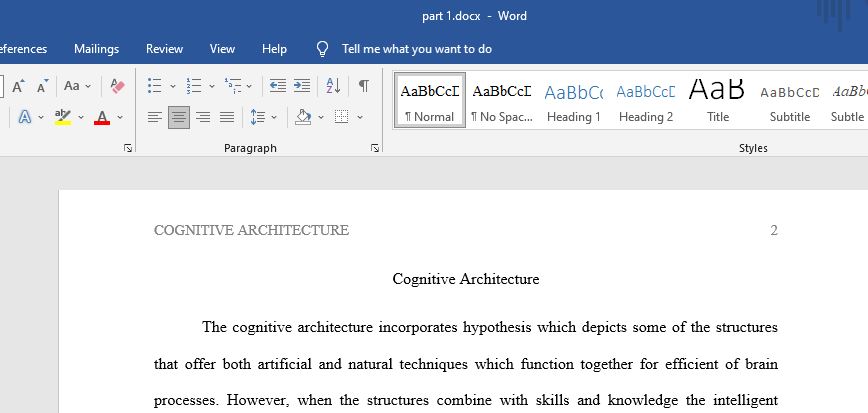Essay- Cognitive Psychology
First:
As we know from our reading, cognitive architecture is often thought of as a blueprint for intelligent agents. Cognitive architecture proposes that artificial computational processes act like certain cognitive systems. Most often, they mirror cognitive systems like a person, or act intelligent under some definition. Some early theories of cognitive architecture include Soar and ACT-R. These theories originally focused only on the internal information processing of an intelligent agent, including tasks like reasoning, planning, solving problems, and learning concepts. More recently, many architectures including Soar, ACT-R, PreAct, ICARUS, CLARION, FORR have expanded to include perception, action, and also affective states and processes including motivation, attitudes, and emotions. As you can see, the field is growing rapidly!
For this blog, summarize the ACT-R theory of computer simulated problem solving and discuss a potential example of how ACT-R theory could apply to your future career of choice. Be sure to use examples to demonstrate your understanding.
Second:
you will discuss relevant topics in the cognitive psychology field.
Research paper directions:
Memory is one of the most important concepts we will study in the field of cognitive psychology. In order to learn more about these ideas, your Research Paper will focus on this area. For the Research paper, please provide a brief (no more than 1 page) summary of:
Short-term and working memory
Long-term memory structure
Long-term memory encoding, retrieval, and consolidation.
After describing the above, select at least 4 of the following questions below. Be sure to answer each in detail.
You should have already researched many of these topics for your literature review. Include information from your literature review in your answers.
This section of your paper should be at least 3 full pages.
Describe the case of the “Central Park Five.” What implications does this case have for criminal interrogation procedures? What parts of memory play a role in the related concepts we have studied?
Describe examples of how odor and music can enhance autobiographical memories. How have music-enhanced autobiographical memories been used with Alzheimer’s patients? What parts of memory play a role in the related concepts we have studied?
What is the evidence, both from “real life” and from laboratory experiments, that eyewitness testimony is not always accurate? Describe how the following factors have been shown to lead to errors in eyewitness testimony: weapons focus, familiarity, leading questions, feedback from a police officer, and post-event questioning. What parts of memory play a role in the related concepts we have studied?
What is expert-induced amnesia, and how does it relate to an important property of procedural memory? What parts of memory play a role in the related concepts we have studied?
What is priming? Repetition priming? Describe the Graf experiment, including the results and how they support the idea that priming is a form of implicit memory.
Describe the Perfect and Askew advertising experiment. What is the propaganda effect, and why could it be considered a form of priming. What parts of memory play a role in the related concepts we have studied?
What is procedural memory? Describe the mirror drawing experiment and other examples from the chapter. Why is procedural memory considered a form of implicit memory? Discuss other memory-related concepts that play a role in procedural memory.
Describe the phonological similarity effect, the word length effect, and the effect of articulatory suppression. What do these effects indicate about the phonological loop? What parts of memory play a role in the related concepts we have studied?
Describe the visuospatial sketch pad, the Shepard and Metzler mental rotation task, Della Sala’s visual pattern task, and Brooks’s “F” task. What does each task indicate about the visuospatial sketch pad. What parts of memory play a role in the related concepts we have studied?
The physiology of working memory has been studied (1) by determining how removal of the PFC in monkeys affects memory and (2) by recording neural responses from monkeys. What have these studies taught us about working memory and the brain?
How is Stokes’s model of working memory a departure from the idea that there has to be continuous neural activity during the delay between presenting a stimulus and remembering it? What parts of memory play a role in the related concepts we have studied?
Describe how Daneman and Carpenter discovered the relationship between working memory capacity, reading comprehension, and verbal SAT scores. What parts of memory play a role in the related concepts we have studied?
Describe Vogel’s experiment that measured the event-related potential in participants with high-capacity working memory and those with low-capacity working memory as they were carrying out a change detection task. What does the result of this experiment indicate about how the central executive allocated attention in these two types of participants?
Guidelines and Expectations
In meeting this requirement, you will be asked to submit 4 full pages of content in your paper which do not including the title and reference pages. You should use at minimum 5 scholarly sources from the JWU library. You can use your textbook as a 6th source if desired. This paper should be in APA style. A good guide for this style is the Purdue Owl Style Guide.
The overall guidelines are as follows:
Title Page
Body of the paper which is at least 4 full pages of content. You should use in-text references giving credit to the authors in each paragraph of the paper.
Reference page in APA style
Please know that any Research Papers submitted with issues of academic integrity will be given a score of 0.
Requirements:
Answer preview:

word limit:402
